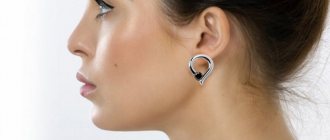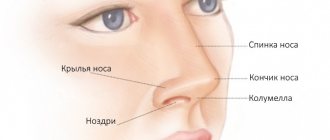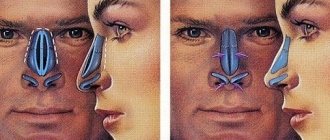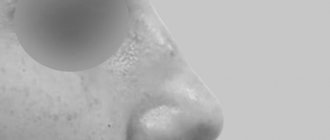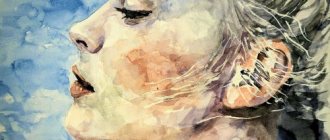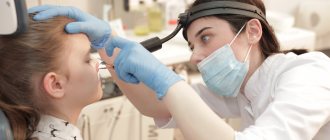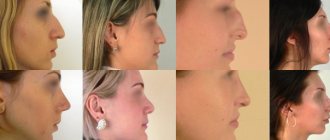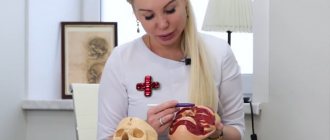A deviated nasal septum is a very common deviation that occurs in children and adults. Normally, the septum is located in the middle and separates the left and right halves of the nose. When curved, the shape of the cartilaginous plate changes; it deviates to the right or left, which changes the division of air between the cavities of the nose and disrupts its functions. Nasal breathing becomes difficult, snoring appears, inflammatory changes develop in the mucous membrane, and the help of a specialist is required.
At CELT you can consult an otorhinolaryngologist.
- Initial consultation – 3,000
- Repeated consultation – 2,000
Make an appointment
How is the nasal septum structured?
The nasal cavity is the beginning of the respiratory system and has a rather complex structure. It is a channel shaped like a prism. A plate passes exactly in the middle of the cavity and separates the passages. The anterior part of the septum is represented by cartilaginous tissue, mobile and soft, which protrudes outward and forms the nose. The back part is formed by bone plates.
Ideally, the nasal septum should be strictly in the middle, but in almost 80% of adults and children it deviates to one side or the other. This is due to the fact that the anterior part of the septum is easily displaced and is susceptible to injury. In many patients, the cartilage plate is curved, and deviations such as spines, humps and ridges are formed.
In the nasal cavity, air moves in an arc; when you inhale, it flows from top to bottom to the internal passages, and when you exhale, it is removed by the lower nasal passages. When the nasal septum is changed, nasal breathing changes. In the case of significant curvature of the cartilaginous plate, negative pressure is created in the cavity, which leads to the fact that the septum is pressed against the wings of the nose. In this case, one nasal passage is completely excluded from the respiratory process. Displacements of the septum can be physiological, post-traumatic, or compensatory.
How does non-surgical rhinoplasty work?
Nose correction without surgery includes several techniques:
- Contour or injection plastic surgery is the most popular method of non-surgical rhinoplasty;
- Bio-reinforcement or plastic threads;
- Administration of hormonal agents (kenalog, diprospan).
The essence of contouring is the injection of special preparations, often based on hyaluronic acid, which permanently change the configuration of areas of the nose. Injection of drugs that add volume - fillers - allows you to correct pits, unevenness and other deformations of the tip of the nose, as well as some types of humps, etc.
The procedure takes no more than 15-20 minutes. The injectable filler is placed under the skin in the injection area. With its help it is possible:
- Smooth out deformations and sharp corners;
- Add volume to individual areas to “balance” all the details of the nose with each other;
- Eliminate asymmetry.
Thread grafting, which is inserted under the skin through tiny punctures, can be used to tighten the wings or the tip of the nose. Injection of hormonal drugs promotes the resorption of excess connective tissue, and is used more often to eliminate the consequences of post-traumatic or postoperative (after surgical rhinoplasty) scarring. Since the last two techniques are rarely used, we will focus on nose contouring.
About physiological factors
In newborns, the nasal septum consists mainly of cartilage with small areas of ossification. As it develops, bone tissue is formed and its posterior part is transformed. The nasal plate is finally formed by the age of 10; as a rule, it is perfectly smooth. With age, the cartilaginous septum can become deformed due to physiological factors.
- Imbalance between bone and cartilage tissue. During development, tissue formation may be uneven. Such curvatures are manifested by a displacement of the cartilaginous septum to the side or the appearance of characteristic ridges and pronounced spines.
- The bones of the skull develop unevenly. This can lead to changes in the size of the nasal cavity and the septum does not have enough space and becomes deformed.
Causes and varieties
Congenital factors leading to asymmetry include various intrauterine defects that form in the bone, muscle or nervous structure, as well as disproportionate development of the jaw region. The causes of such changes are pathologies during pregnancy, abuse of alcohol and tobacco products, as well as taking narcotic drugs.
Acquired facial asymmetry in an adult or child can be caused by physical damage, infectious pathologies, including those that provoke mouth breathing, as well as malocclusion due to bad habits. Abnormal disproportion is characterized by uneven development of facial muscles, distortion of articulation, as well as other signs that most often turn out to be symptoms of neuropathy.
Characteristic symptoms
Severe deformation of the nasal septum significantly impairs the quality of life and requires surgical treatment. Most often, patients are concerned about the following symptoms:
- Regular swelling and “stuffiness” of the nose on both sides or only on one.
- Impaired nasal breathing.
- Disturbing snoring and snoring at night.
- Frequent nosebleeds, which occur due to the fact that the mucous membrane becomes significantly thinner.
- Violation of facial aesthetics due to the asymmetrical shape of the nose. Quite often, along with the cartilaginous plates, its back is also bent.
- Increased incidence of illnesses, persistent cough, runny nose, high temperature, sore throat.
- Dryness in the nasal cavities.
- Hearing acuity decreases.
- Olfactory functions decrease.
- Absent-mindedness appears, memory suffers, and performance decreases due to the fact that nasal breathing is impaired and less oxygen enters the blood.
A patient who notices these symptoms should come to an appointment with an otolaryngologist. Neglecting your own health leads to the fact that the immune system, cardiovascular, respiratory, etc., suffers.
Patients suffering from chronic sinusitis, sinusitis and other diseases of the paranasal sinuses should definitely consult a specialist about the need to straighten the nasal septum.
Nasal asymmetry: defect, complication or normal?
Strict, millimeter-calibrated proportions are the lot of engineers, mathematicians and architects. Nature does not operate with round numbers, so no person can boast of perfectly smooth facial features.
Nasal asymmetry occurs in more than 80% of the inhabitants of our planet. It can manifest itself in different sizes or shapes of the nostrils, unequal wings, deviation of the back and tip from the midline. Sometimes such nuances are completely invisible to others, but sometimes they literally catch the eye.
Can this be fixed and if so, how? Should you always seek help from a plastic surgeon? And what should you do if a similar problem appears after the operation? TecRussia.ru answers the most pressing questions.
↑ How does nasal asymmetry occur?
This condition (it should not always be called a defect) can be congenital or acquired:
- In the first option, the cause is the individual characteristics of the structure and development of the facial bones of the skull and cartilage, from minor to very serious, such as cleft lip and/or cleft palate. Most often, the nasal septum is to blame: it can grow faster than the outer bones of the nose, become deformed and displace all adjacent anatomical structures. Due to its curvature, nasal breathing is almost always disrupted to one degree or another, differences in the size of the nostrils or wings of the nose are visually noticeable, and the back and tip may shift sideways from the center line.
- Acquired asymmetry can be a consequence of surgery on any part of the face, incl. rhinoplasty or septoplasty. Usually this is not a consequence of the surgeon’s mistakes, but only a temporary imbalance in proportions caused by swelling, which returns to normal after a few weeks or months. Another possible cause is mechanical injury. Here, everything often happens the other way around: the displacement of bone and cartilaginous structures is unnoticeable in the first days and weeks due to swelling and bruises. And after a while, returning everything to its place will be much more difficult than immediately after the damage (see also the article “How to fix your nose after a fracture”).
↑ Can this be fixed?
The only reliable way to correct defects of the septum, nostrils, wings and other nasal structures is plastic surgery - rhinoplasty or rhinoseptoplasty. The first step here will be a face-to-face consultation, during which the surgeon will examine the problem area and make a decision on the advisability of intervention (we will talk about why such a decision is not always made “in favor of the patient” below). Next, the nature and causes of the problem are precisely determined and the most suitable technique is selected to eliminate it:
- If the asymmetry of the back, tip, nostrils and/or wings of the nose is caused by septal defects, work is carried out with it. Sometimes it can be relatively easily aligned and installed in a new position; in more complex cases, the curved areas are completely removed, which are then replaced with grafts - they are usually obtained from a piece of the patient's rib. It sounds scary, but in fact it is a relatively simple and low-traumatic procedure (see also the article “Deviated nasal septum”).
- Sometimes the problem is associated with improper placement of the medial crus, a section of cartilage that laterally supports the columella. Its displacement to one side leads to the fact that the nostrils and wings look very different in size, and the tip may deviate from the midline. The correction in this case consists of a slight shift of the leg in the desired direction.
- More serious defects - consequences of injuries, congenital pathologies, etc., may require complex, sometimes multi-stage operations, during which not only the cartilaginous but also the bone structures of the nose are repositioned and the lack of tissue is compensated. There is no single technique here and an individual correction plan is developed for each patient.
| Photos before and after surgical plastic surgery of a severely crooked nose (1) and a nose with an asymmetrical tip (2): | |
Some surgeons allow the use of non-surgical (injection) rhinoplasty to correct minor asymmetries. Typically, dense fillers based on calcium hydroxypatite, polycaprolactone, etc. are used for this, which are injected into the soft tissues and increase their volume. In this way, you can correct the unevenness of the tip and back, but it is not always possible to align the nostrils and wings. And, unlike surgery, the result will last only for 6-12 months, after which the procedure will have to be repeated.
- The best rhinoplasty surgeons: official ranking TecRussia.ru
There are also various devices for correcting the shape of the nose. Usually these are some form of clothespins that need to be worn on the face for a long time: supposedly, due to constant pressure, you can change the shape of soft tissues, cartilage and even bones. But, unfortunately, such devices cannot provide a noticeable aesthetic result even with constant use. But they give their owner a false sense of control over the situation, which is what determines the demand for them.
| Photo 3 – results of rhinoplasty, nostrils of different shapes and sizes have been corrected: | |
| Photo 4 – irregularities in the back and tip of the nose were corrected using fillers (without surgery): | |
↑ Asymmetry after rhinoplasty
What could be worse than an initially crooked nose? Only irregularities left after the already performed plastic surgery, which the patient sees with surprise when the bandage is removed for the first time. And no matter how much surgeons explain to frustrated ladies that everything will return to normal as soon as the swelling completely subsides (and this will happen no earlier than six months), many rashly begin to prepare for a second operation a week after the first.
- How long does it take for swelling to go away after rhinoplasty and how to remove it
What's really going on? The blood supply to the face is fundamentally different from other parts of the body. Significantly more blood flows to the head per unit volume of tissue. This, on the one hand, promotes rapid healing, but, on the other hand, the same rapid increase and long-term (up to 6-8 months) persistence of edema, the “behavior” of which is sometimes quite unpredictable:
| Photo 5 – asymmetrical nostrils and nose a few weeks after rhinoplasty (they will return to normal after a few months): | |
- it can move to different parts of the nose, causing its back or tip to deviate in one direction or the other from the midline;
- often intensifies at certain times of the day, for example, in the evening;
- may go away relatively quickly in one area of the nose, but persist for a long time (several months) in another.
Thus, nasal asymmetry after rhinoplasty is normal. At first, the nostrils may be different, and the wings and back often look not quite even, and the tip - too large or displaced. But until the swelling subsides completely, it is absolutely inappropriate to draw conclusions about the aesthetic results of the operation - and, moreover, to plan a repeat one.
↑ Why are such operations not performed on all patients?
For most people, the presence of a slight disproportion is not just the norm, but a part of their individuality that shapes their unique appearance. This is evidenced by numerous studies in which scientists compared images composed of the double left and right halves of the face of one person. Even the recognized beauty Marilyn Monroe was no exception.
As it turns out, the criterion of beauty is often not the mathematical correctness of facial features, but their overall harmony and balance. And its important component can be the asymmetrically located nose, which is slightly shifted towards the narrower half. If such a “defect” is corrected (for example, surgically), then the entire delicate relationship will be disrupted, and the aesthetic result will be unsatisfactory.
Another important factor is our tendency to overly critically evaluate our own appearance . We are talking about those cases when there is no noticeable cosmetic defect, but a slight displacement of the back or tip of the nose is given “universal” significance. As a result:
- a person is ashamed of his own face;
- believes that this imperfection is noticeable not only to him, but also to others;
- is embarrassed to be photographed or chooses head positions for the photo so that the asymmetry is not noticeable;
- worries a lot about this, up to the appearance of more serious psychological problems, difficulties with communication, being in society, etc.
| Photo 6 - examples of minor asymmetry of the nostrils, which is not advisable to correct surgically: | |
It is extremely difficult to carry out an operation that would completely satisfy a patient with such complexes. In this case, the initial dissatisfaction with oneself and one’s appearance is usually transferred to the result of plastic surgery, in which minor “irregularities” and “inconsistencies with the ideal” will certainly be found (psychologists call this condition dysmorphophobia).
- American plastic surgeon Ronald V. DeMars has an interesting way of helping patients realize the real extent of their alleged problem. “When a person comes to me for a consultation with a request to remove minor asymmetry of the nose or other part of the face, I give him a glossy magazine and ask him to show me 5 photographs of the most attractive, in his opinion, celebrities. We then look at their faces close up and on each one I point out at least 5 asymmetrical areas. This is not difficult to do, since not a single person in the world has perfectly equal proportions.”
- Facial symmetry as a criterion of external beauty: the opinion of plastic surgeon G.S. Chemyanova
Thus, before looking for ways to correct an existing deficiency, you need to honestly answer the question of why exactly this is needed. Objective reasons for seeking help from a plastic or ENT surgeon are:
- violation of nasal breathing caused by incorrect position of the septum or other osteochondral structures;
- a serious external defect of the nose, which is clearly visible from the outside, clearly distorts facial features and leads to objective difficulties in communicating with people.
The desire to perform an operation to harmonize the face and make it more attractive, if a person understands that rhinoplasty alone cannot correct all the problems in life, is also a very good reason. In other situations, rhinoplasty is unlikely to give the desired result.
↑ Experts' opinions:
| Abrahamyan Solomon Maisovich leading plastic surgeon at Frau Klinik: Initially, nasal asymmetry is a physiological feature that only intensifies over the years. The operation should be performed if there are problems with nasal breathing or the proportions are disturbed: the septum, the osteochondral part of the external nose, etc. are bent, and therefore the person experiences discomfort. Today, I consider microrhinoplasty to be the safest and most effective method for correcting this problem. It allows you to carefully perform all surgical procedures in an extremely short time (from 50 minutes to 1.5 hours), maintain natural proportions, and minimize injuries to blood vessels and nerve endings. This approach helps not only the surgeon, but also the patient himself - the rehabilitation period is much faster and easier (there are no bruises or hematomas), and you can return to your normal lifestyle within a few days. As for asymmetry that occurs after surgery, this happens quite rarely and depends on the following factors:
If you feel like “something has gone wrong,” you need to contact your plastic surgeon to take preventive measures. |
| Akopov Aram Arturovich plastic surgeon, rhinosurgeon, Sharm clinic: The causes of nasal asymmetry can be congenital (genetic) - they can appear both immediately and during the process of growing up, or acquired - when, due to an injury in childhood, the development of one half of the face could lag behind. In the first case, a violation of proportions is usually associated with different volumes of tissue on the right and left sides of the nose, when the length of the cartilage or wings, the height of the bones are noticeably different, or the septum is curved. Also, a combination of asymmetry with a cleft palate and “cleft lip” is possible. If such a condition causes aesthetic discomfort in the patient, creates complexes, worsens the quality of life, or interferes with breathing, the problem must be solved only surgically. For example, if deviations of the tip of the nose are caused by different lengths/widths of its cartilages, then it is necessary to excise the excess volume and apply special sutures to build a new symmetrical frame. Open rhinoplasty allows you to perform this as accurately as possible. The asymmetry that arises after rhinoplasty is a direct complication, but its likelihood is extremely low; most often the culprit is ordinary swelling, which gradually goes away. If the problem persists for a year, corrective surgery may be required. |
| Grigoryants Vladislav Semenovich plastic surgeon, Arbat Aesthetic clinic: There is no absolute symmetry in any face. Differences between the right and left sides are often noticeable at the level of the wings of the nose, in the shape of the nostrils, etc. It is not always possible to completely rid the patient of such a “flaw”. After all, the bone structure of the skull also matters here, which, like our soft tissues, is also not perfectly smooth. This can only be an indication for surgery if the difference is visible to the naked eye, and not only to the patient in the mirror or in a selfie at a certain angle and lighting (which is most often the case), but really to everyone. This mainly occurs as a result of injury, or is a congenital defect - and in addition to aesthetic problems, it is also accompanied by impaired breathing. |
How is diagnosis carried out?
At the CELT clinic, a thorough examination of the patient by an otolaryngologist is carried out. During the preliminary examination, the ENT doctor assesses the effectiveness of nasal breathing, examines the nasal cavity and the state of smell. Using special instruments, rhinoscopy is performed to assess the degree of curvature of the nasal septum.
Anterior rhinoscopy is performed using nasal dilators as well as probes. This method helps to detect tumors, polyps, various hematomas and inflammatory processes. Posterior rhinoscopy involves examining the nose from the oral cavity. For examination, diagnostic mirrors and spatulas are used.
In addition to rhinoscopy, MRI of the skull can also be used to assess the degree of curvature. Computer diagnostics helps to establish the anatomical features of the nose and identify head injuries that could lead to a deviated septum.
Types of deviated nasal septum
The vast majority of adults have slight deviations of the nasal septum. But they do not interfere with proper air circulation through the nostrils and proper breathing.
The following types of deviated nasal septum are known:
- deviated nasal septum;
- crest;
- thorn;
- a combination of various types of curvature.
Most often, people have a deviated nasal septum in the front part. Deformations of the posterior part of the nasal septum are less common.
Configuration of the nasal septum and turbinates with a deviated septum: a - slight curvature of the nasal septum; b — S-shaped curvature of the nasal septum; c — curvature of the nasal septum at an angle.
Our doctors
Gogolev Vasily Gennadievich
Doctor - otorhinolaryngologist
20 years of experience
Make an appointment
Zharova Galina Gennadievna
Doctor - otorhinolaryngologist, member of the European Society of Rhinologists, doctor of the highest category
40 years of experience
Make an appointment
Debryansky Vladimir Alekseevich
Doctor - otorhinolaryngologist, doctor of the highest category
34 years of experience
Make an appointment
When is surgery necessary?
Surgical straightening of the nasal plate is performed only if the problem cannot be solved with medication. The operation is called septoplasty, and it is performed from the age of 18 (by this age the septum is finally formed).
The operation is indicated in the following cases:
- With severe impairment of nasal breathing.
- When curved areas clog the exits from the sinuses and cause the development of sinusitis and sinusitis.
- During operations to improve the shape of the nose (rhinoplasty).
General overview
From a medical point of view, facial asymmetry means a discrepancy in the structural arrangement of the elements of the left and right sides, expressed in the hypertrophied development of the mandibular region and chin, an elongated or distorted contour shape, as well as a violation of natural anatomical proportions. The classification provides for assessment of 25 parameters, changes in which can be caused by both congenital anomalies and acquired abnormalities that are the consequences of injuries or illnesses.
How is surgery to correct a nasal septum performed?
At the CELT clinic, minimally invasive surgery to correct the nasal septum is performed by experienced otolaryngologists and plastic surgeons. The intervention is performed under general anesthesia, and the patient is discharged home on the same day. Alignment of the plate occurs by removing the curved part, shifting it to the middle, or straightening it using special equipment. After correcting the shape, the partition is securely fixed in the correct position.
Detailed information about septoplasty is posted on the corresponding page of our website. The operation is completely safe and effective; surgical intervention allows the patient to permanently relieve nasal congestion and cosmetic defects.
Take care of your own health, make an appointment with CELT otorhinolaryngologists right now to diagnose and treat the problem.
Facial asymmetry in adults - how to treat
Treatment depends on the causes of the disease and the severity of the changes. When a diagnosis of facial asymmetry is made, one or more doctors decide how to correct the anomaly. For mild asymmetry, conservative correction methods are sufficient:
- An asymmetrical bite is corrected using splinting, braces and other orthodontic aids.
- When muscles are damaged, drug therapy, physiotherapy, and massage are used. With reduced muscle tone, myostimulation and gymnastics are necessary. Massage relaxes/tones muscles, eliminates pain.
- For neuritis of the facial nerve, treatment is carried out in a hospital. The doctor prescribes medication and physiotherapeutic treatment.
Surgery is required when the structure and function of the jaw joint changes.
Craniosacral manual therapy and massage help correct the asymmetrical skull in children and alleviate the condition of adult patients. In case of significant defects in the articular bones, the neurosurgeon prescribes prosthetic surgery.
At the Clinic of Manual Medicine “Galia Ignatieva MD”, correction of soft tissue lesions is performed using cosmetic minimally invasive methods:
- Botox injections;
- thread lifting;
- hardware massage;
- lipofilling;
- injection of fillers.
Rice. 4. The result of conservative treatment - before and after.
If the asymmetry is severe and does not respond to conservative treatment methods, then a surgical solution to the problem is indicated. It could be plastic surgery.
If there is an abnormal development of the joint of the jaw bones, maxillofacial surgery is prescribed. The neurosurgeon performs surgical treatment of complications of innervation and pathology of the facial nerve.
Facial asymmetry, the treatment of which may require a whole range of measures, is difficult to eliminate if the patient consults a doctor late. Early diagnosis, the professionalism of the doctors at the Manual Medicine Clinic “Galia Ignatieva MD” and compliance with their recommendations in half the cases lead to an improvement in the condition.
Our services
The administration of CELT JSC regularly updates the price list posted on the clinic’s website. However, in order to avoid possible misunderstandings, we ask you to clarify the cost of services by phone: +7
| Service name | Price in rubles |
| Appointment with a surgical doctor (primary, for complex programs) | 3 000 |
| X-ray of the paranasal sinuses | 2 200 |
| Septoplasty | 68 000 — 98 000 |
All services
Make an appointment through the application or by calling +7 +7 We work every day:
- Monday—Friday: 8.00—20.00
- Saturday: 8.00–18.00
- Sunday is a day off
The nearest metro and MCC stations to the clinic:
- Highway of Enthusiasts or Perovo
- Partisan
- Enthusiast Highway
Driving directions
